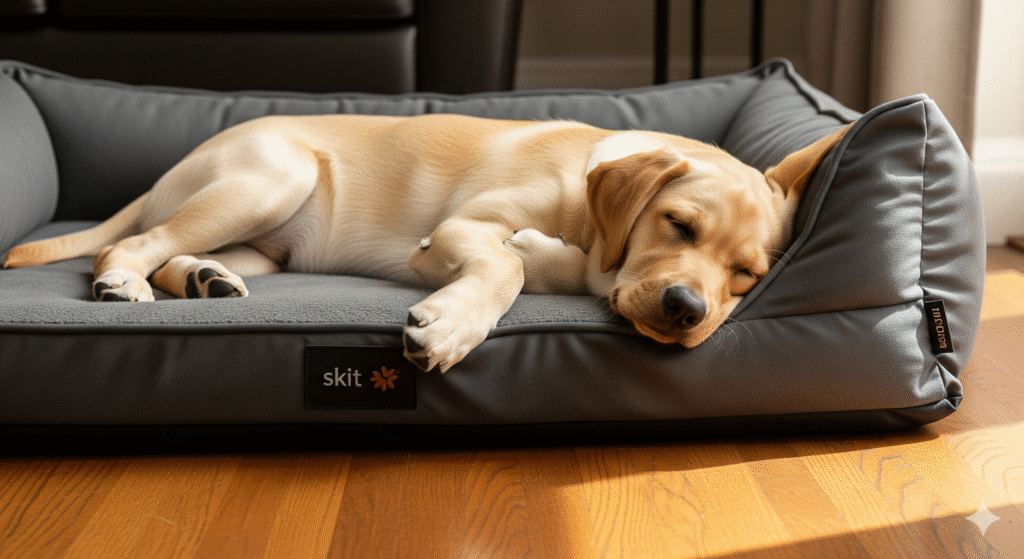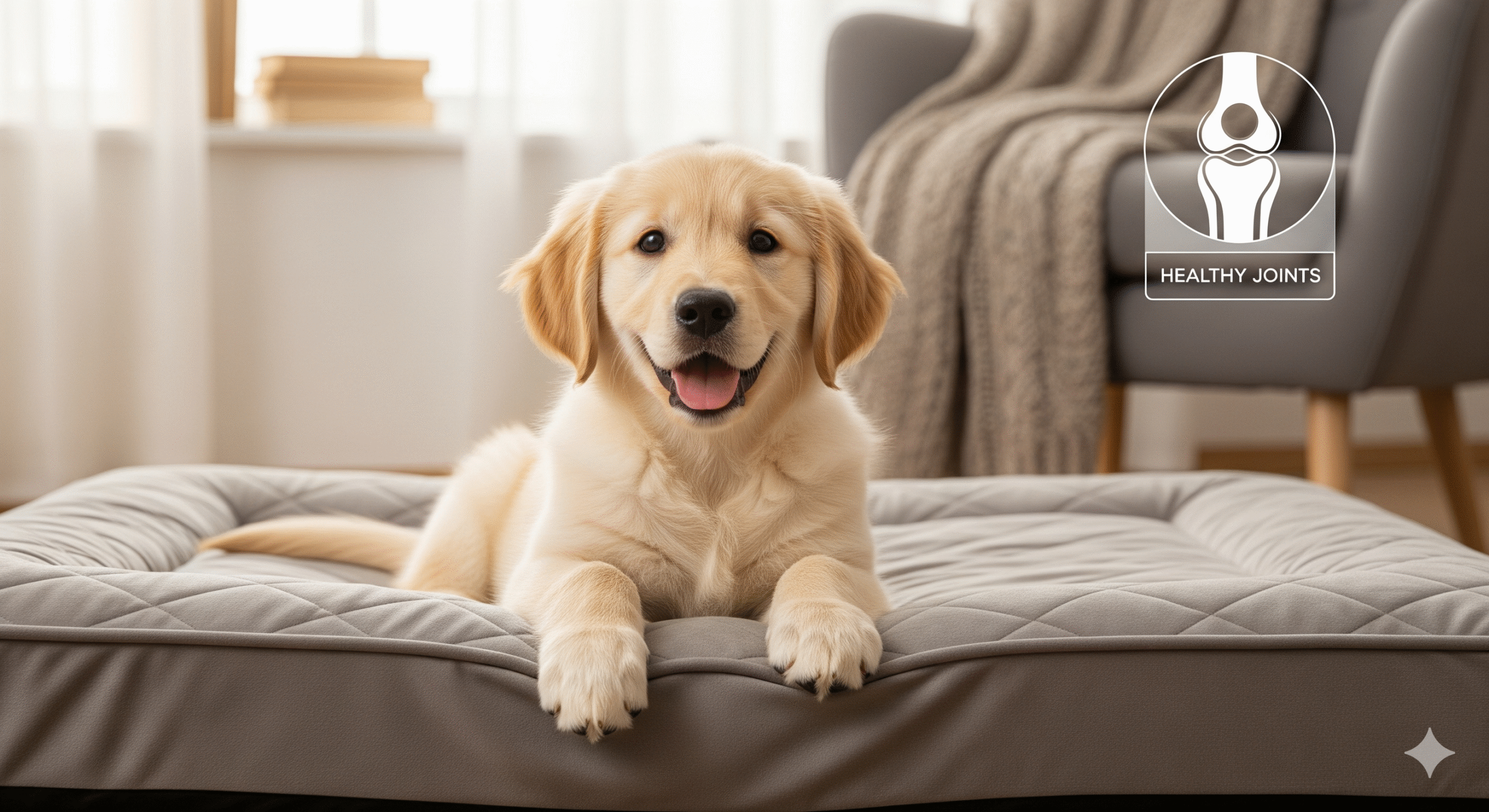Your puppy spends up to 20 hours a day sleeping, and the surface they sleep on is far more than just a place to nap—it’s a foundational element of their skeletal health. An orthopedic puppy bed is not a luxury; for many breeds, it’s a crucial investment in preventing future pain and mobility issues. While a young puppy may seem bouncy and resilient, their growing joints, bones, and cartilage are incredibly vulnerable. The right bed provides the support needed for proper development, while the wrong one can exacerbate problems like hip and elbow dysplasia.
This guide will help you navigate the world of orthopedic support, cutting through the marketing claims to find a bed that truly benefits your growing dog. We’ll focus on why puppies have unique needs and how to choose a bed that will support them from their playful puppy months into their senior years.
Here’s what we’ll cover:
✔️ Why puppies need specialized support (it’s not just for older dogs!)
✔️ The key differences between orthopedic, memory foam, and regular beds
✔️ A detailed comparison of the top 5 orthopedic beds for puppies in 2024
✔️ How to choose the right size, thickness, and material for your breed
✔️ Special considerations for large/giant breeds and dogs prone to dysplasia
✔️ Features that add value like waterproof covers and non-skid bottoms
Let’s find the perfect supportive throne for your puppy’s well-deserved rest.
Why Your Puppy Needs an Orthopedic Bed 🦴
Puppyhood is a period of rapid growth and development. Between 4 and 8 months of age, puppies can be especially prone to growing pains and conditions like panosteitis (“pano”).
- Joint Support: Orthopedic foam evenly distributes weight, relieving pressure on developing joints in the hips, elbows, and shoulders. This is critical for large and giant breeds like German Shepherds, Labradors, and Great Danes.
- Spinal Alignment: A supportive bed keeps a puppy’s spine in a neutral position during sleep, preventing awkward twisting and stress on the vertebrae.
- Prevention Over Treatment: Supporting joints from day one can help prevent the early onset of arthritis and other degenerative joint diseases. It’s much easier to prevent damage than to reverse it later.
- Quality of Sleep: Deep, uninterrupted sleep is when growth hormone is released. A comfortable bed means better sleep, which is essential for healthy development.
Orthopedic vs. Memory Foam: What’s the Difference? 🤔
These terms are often used interchangeably, but there is a key distinction:
- Orthopedic Foam: This is a general term for any high-density foam designed to provide superior support and relieve pressure points. It can be made from various materials.
- Memory Foam (Viscoelastic Foam): This is a type of orthopedic foam that is temperature-sensitive. It softens with body heat, allowing it to contour precisely to your puppy’s shape. It’s excellent for pressure relief but can sometimes sleep hot.
The best puppy beds often use a combination of high-density base foam for support with a memory foam topper for comfort.
Key Features to Look For in an Orthopedic Puppy Bed
1. Foam Density & Thickness 📏
- Density: Measured in pounds per cubic foot (PCF). Look for a minimum of 1.5 PCF for a supportive bed. Higher density (e.g., 2.5 PCF) offers more support, especially for heavier breeds.
- Thickness: A bed should be thick enough that your puppy’s joints don’t press against the floor. At least 3-4 inches of foam is a good starting point for a puppy. Larger breeds will need 5+ inches as adults.
2. Supportive Bolsters 🛡️
- Bolsters (the raised edges) provide security and a sense of den-like comfort. They also serve as a headrest, supporting the neck and spine.
3. Removable, Washable Cover 🧼
- This is non-negotiable for a puppy. Accidents will happen. Look for a cover that is machine washable, durable (like microfiber or canvas), and ideally waterproof or water-resistant.
4. Non-Skid Bottom ⚠️
- This prevents the bed from sliding on hardwood or tile floors, making it safer for playful puppies and preventing frustration.
5. CertiPUR-US® Certification ✅
- This certification means the foam is made without harmful chemicals, heavy metals, or formaldehyde, and has low VOC emissions. This is important for a puppy that might try to chew their bed.
Top 5 Orthopedic Puppy Beds for 2024 🏆
| Product | Best For | Key Feature | Foam Type & Thickness |
|---|---|---|---|
| BarksBar Orthopedic Bed | Overall Value & Support | 4-inch egg crate foam topper, waterproof liner | High-density foam + memory foam topper, 4″ total |
| Big Barker Orthopedic Bed | Large/Giant Breeds | 7″ thick, 3-layer foam, 10-year warranty | Therapeutic-grade foam, 7″ total |
| FurHaven Plush Ball Pillow Bed | Comfort & Variety | Multiple firmness levels, Jumbo size available | Orthopedic foam, 3.5″ – 4.5″ thick |
| PetFusion Ultimate Dog Bed | Supportive Bolsters | Solid 4″ memory foam core, water-resistant | 100% memory foam, 4″ total |
| Brumate Dog Bed | Cooling & Chew-Resistant | Nylon cover, cooling gel foam layer | Cooling gel foam + support foam, 4″ total |
Special Considerations for Large & Giant Breed Puppies 🐕🦺
The stakes are higher for these pups. Their rapid growth rate puts immense strain on their joints.
- Invest in an Adult-Sized Bed: It’s more cost-effective to buy the bed they will grow into. Choose a “jumbo” or “giant” size from the start.
- Prioritize Thickness and Density: Do not compromise on foam. Look for beds that are at least 5 inches thick with high-density foam (1.8 PCF or higher).
- Look for a Warranty: A company that offers a long warranty (like Big Barker’s 10-year guarantee) stands behind its product’s ability to resist sagging.
Puppy-Proofing Your New Bed 🐶
A fancy bed is useless if your puppy destroys it.
- Supervise Initially: Don’t leave a puppy alone with a new bed until you’re sure they won’t chew it.
- Provide Alternatives: Ensure they have plenty of approved chew toys.
- Choose Durable Materials: A nylon or canvas cover is more chew-resistant than plush microfiber.
- Use a Crate: The safest place for a puppy (and their bed) when unsupervised is in a crate.
Final Checklist for Choosing an Orthopedic Bed ✅
☑️ The foam is at least 1.5 PCF density and 3-4 inches thick.
☑️ The cover is removable, machine washable, and water-resistant.
☑️ The bottom is non-skid to prevent sliding.
☑️ The bed is large enough for my puppy to stretch out fully.
☑️ The materials are certified non-toxic (CertiPUR-US®).

“Playdates with other vaccinated, gentle puppies are a cornerstone of good socialization. They teach your puppy bite inhibition—how to control the force of their bite—through feedback from other dogs. But what do you do when your puppy turns those sharp teeth on you during play? It’s important to consistently teach them that human skin is far more sensitive than a dog’s fur. If your puppy gets overexcited and starts mouthing you, the game must stop immediately. For a comprehensive set of techniques to manage and redirect this behavior during play and everyday interactions, consult our detailed guide: How to Stop Puppy Biting: Why They Do It & Fixes.”






